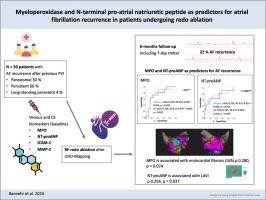Myeloperoxidase and N-terminal proatrial natriuretic peptide as predictors for atrial fibrillation recurrence in patients undergoing redo ablation
IF 2.5
Q2 CARDIAC & CARDIOVASCULAR SYSTEMS
引用次数: 0
Abstract
Background
Atrial fibrillation (AF) is a progressively developing arrhythmia. Electroanatomic remodeling may play an important role, both in the development of the disease and in the perpetuation and thus in the recurrence of AF.
Objective
This study aimed to investigate potential biomarkers myeloperoxidase (MPO), N-terminal proatrial natriuretic peptide (NT-proANP), intercellular adhesion molecule-1, and matrix metalloproteinase-2 and their predictive value for AF recurrence in patients undergoing redo ablation.
Methods
In this single-center prospective cohort study, 50 consecutive patients underwent ultra high-density mapping and redo ablation. Biomarkers were determined before ablation and at 6-month follow-up. Seven-day Holter was conducted to check for AF recurrence (>30 seconds).
Results
Eleven (22%) patients showed AF recurrence after redo ablation. Receiver-operating characteristic curve analysis revealed venous MPO and NT-proANP (area under the curve [AUC] 0.755, 95% CI 0.599–0.912, P = .010; and AUC 0.752, 95% CI 0.551–0.953, P = .011) as acceptable predictors for intermediate AF recurrence, whereas matrix metalloproteinase-2, intercellular adhesion molecule-1, and established cardiovascular biomarkers such as N-terminal pro–B-type natriuretic peptide, troponin T, and C-reactive protein were not (all AUC <0.600). MPO and NT-proANP correlated with AF burden (ρ = 0.365, P = .005; and ρ = 0.362, P = .005). While MPO was associated with atrial fibrosis in the endocardial map (ρ = 0.280, P = .024), NT-proANP correlated with left atrial volume index (ρ = 0.256, P = .037). There were no significant differences in biomarkers concentrations with regard to venous and coronary sinus samples.
Conclusion
MPO and NT-proANP are of predictive value for AF recurrence in patients undergoing redo ablation. While MPO correlated with endocardial fibrosis, NT-proANP was associated with left atrial volume.

髓过氧化物酶和 N 端前房性钠尿肽作为接受重做消融术患者心房颤动复发的预测因子
背景心房颤动(房颤)是一种逐渐发展的心律失常。电解剖重塑可能在房颤的发病、持续和复发中发挥重要作用。本研究旨在探讨潜在的生物标志物髓过氧化物酶(MPO)、N-末端前房性钠肽(NT-proANP)、细胞间粘附分子-1 和基质金属蛋白酶-2 及其对接受再次消融术患者房颤复发的预测价值。在消融前和随访 6 个月时测定了生物标志物。结果7名患者(22%)在重新消融术后出现房颤复发。接收者工作特征曲线分析显示静脉 MPO 和 NT-proANP(曲线下面积 [AUC] 0.755,95% CI 0.599-0.912,P = .010;AUC 0.752,95% CI 0.551-0.953,P = .011)为可接受的中度房颤复发预测指标,而基质金属蛋白酶-2、细胞间粘附分子-1 和 N 端前 B 型利钠肽,肌钙蛋白 T 和 C 反应蛋白等成熟的心血管生物标记物则不是(所有 AUC 均为 0.600)。MPO和NT-proANP与房颤负荷相关(ρ = 0.365,P = .005;ρ = 0.362,P = .005)。MPO与心内膜图中的心房纤维化相关(ρ = 0.280,P = .024),而NT-proANP与左心房容积指数相关(ρ = 0.256,P = .037)。结论MPO和NT-proANP对接受重做消融术的患者房颤复发具有预测价值。MPO与心内膜纤维化相关,而NT-proANP与左心房容积相关。
本文章由计算机程序翻译,如有差异,请以英文原文为准。
求助全文
约1分钟内获得全文
求助全文
来源期刊

Heart Rhythm O2
Cardiology and Cardiovascular Medicine
CiteScore
3.30
自引率
0.00%
发文量
0
审稿时长
52 days
 求助内容:
求助内容: 应助结果提醒方式:
应助结果提醒方式:


